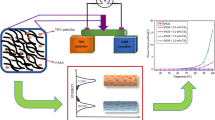Thermoelectric materials have received much attention recently from the viewpoint of global environmental issues and effective utilization of energy resources. Especially those effective at relatively low temperature, such as below 100°C, which are usually abandoned without use, have become noteworthy recently. From this point of view, organic thermoelectric materials are most attractive, because they could be prepared at low cost and applied in various locations due to their flexibility. We have investigated the thermoelectric properties of organic conducting polymers such as polyaniline, polypyrrole, and polyphenylenevinylene, and succeeded in increasing the thermoelectric performance by selecting dopants, stretching conducting films, etc. Recently we have focused on new systems of organic–inorganic hybrid thermoelectric materials. Herein we present the preparation of a novel system of hybrids of polyaniline and bismuth(III) telluride nanoparticles, starting from bismuth(III) chloride and tetrachlorotellurium by using polyvinylpyrrolidone as a protecting reagent, as well as their thermoelectric properties. The hybrids prepared by this particular method showed much higher thermoelectric performance than the starting organic conducting polymer.
Similar content being viewed by others
References
H. Yan and N. Toshima, Chem. Lett., 1217 (1999).
H. Yan, N. Ohno, and N. Toshima, Chem. Lett. 392 (2000).
H. Yan, T. Ohta, and N. Toshima, Macromol. Mater. Eng. 286, 214 (2001).
N. Toshima, H. Yan, and M. Kajita, Proceedings of 21st International conference on Thermoelectrics (2002), p. 147.
H. Yan, T. Ishida, and N. Toshima, Proceedings of 20th International Conference on Thermoelectircs (2001), p. 310.
Y. Hiroshige, M. Ookawa, and N. Toshima, Synth. Met. 156, 1341 (2006).
Y. Hiroshige, M. Ookawa, and N. Toshima, Synth. Met. 157, 467 (2007).
N. Watanabe and N. Toshima, Bull. Chem. Soc. Jpn. 80, 208 (2007).
N. Toshima, Organic-Inorganic Hybrids, Thermoelectric Conversion Technology Handbook, ed. T. Kajikawa (Tokyo: NTS, 2009), pp. 320–326.
A.J. MacDiarmid and A.J. Epstein, Synth. Met. 65, 103 (1994).
H. Yan, N. Sada, and N. Toshima, J. Therm. Anal. Cal. 69, 881 (2002).
Author information
Authors and Affiliations
Corresponding author
Rights and permissions
About this article
Cite this article
Toshima, N., Imai, M. & Ichikawa, S. Organic–Inorganic Nanohybrids as Novel Thermoelectric Materials: Hybrids of Polyaniline and Bismuth(III) Telluride Nanoparticles. J. Electron. Mater. 40, 898–902 (2011). https://doi.org/10.1007/s11664-010-1403-1
Received:
Accepted:
Published:
Issue Date:
DOI: https://doi.org/10.1007/s11664-010-1403-1




